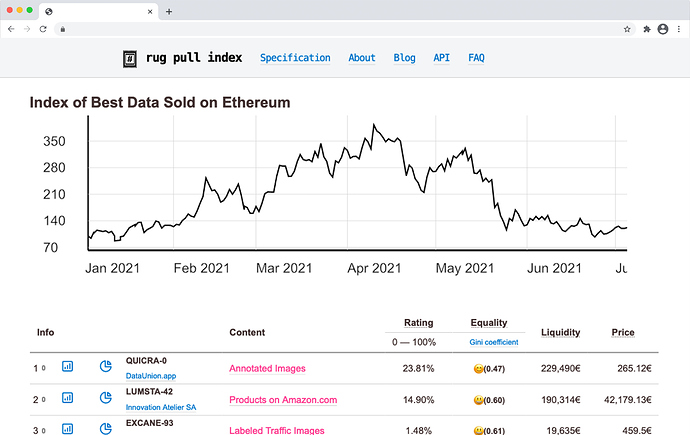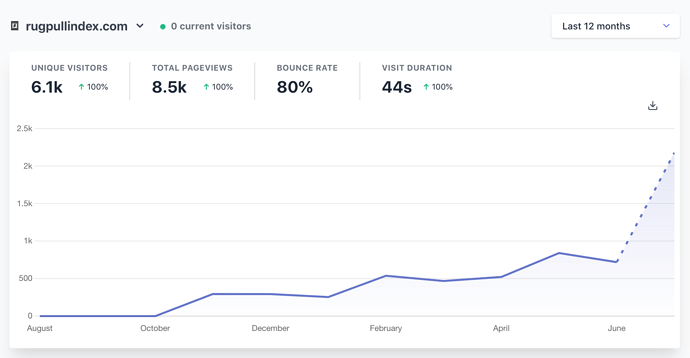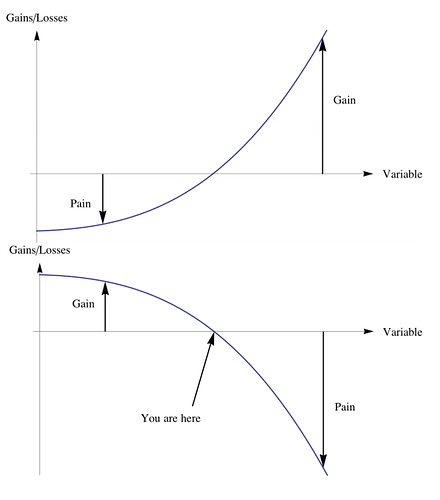rugpullindex.com Proposal R7
Fact Sheet
 Website: https://rugpullindex.com
Website: https://rugpullindex.com
 Address: 0x005241438cAF3eaCb05bB6543151f7AF894C5B58
Address: 0x005241438cAF3eaCb05bB6543151f7AF894C5B58
 Email: tim (at) daubenschuetz (dot) de
Email: tim (at) daubenschuetz (dot) de

 Residence: We’re from Germany and Bahrain
Residence: We’re from Germany and Bahrain

 Category: We’re active as builders but we also do outreach via our blog
Category: We’re active as builders but we also do outreach via our blog
 Metric: Network revenue
Metric: Network revenue
Our Product
 Website: https://rugpullindex.com
Website: https://rugpullindex.com
 Stats: https://plausible.io/rugpullindex.com
Stats: https://plausible.io/rugpullindex.com
 Pitch: “Rug pull index is building the S&P 500 for data.”
Pitch: “Rug pull index is building the S&P 500 for data.”
Executive Summary
rugpullindex.com helps data scientists and investors to make better decisions when buying data online. Our thesis is that markets are proxies for assets’ qualities.
On-chain markets present a huge untapped source of market insight ready to be harvested. By measuring and highlighting the qualities of OCEAN’s data sets, we improve the market’s overall health and performance.
Our long-term goal is to build a scalable decentralized application that allows investors to gain diversified exposure to OCEAN’s best data sets.
Track Record
- We received funding in OceanDAO R2, R3, R4, R5, R6.
- For more reliable runway projections, we convert most of our OCEAN incomes of the OceanDAO into USDC: R2, R3, R4, R5, R6.1, R6.2.
- To improve financial transparency we’re publishing a cash-basis accounting statement from 2021-07-08: document (pdf)
Web Analytics
| Jan 2021 | Feb 2021 | Mar 2021 | Apr 2021 | May 2021 | 2021-07-04 | |
|---|---|---|---|---|---|---|
| Unique visitors | 254 | 538 | 468 | 462 | 841 | 2800 |
| Pageviews | 302 | 737 | 764 | 758 | 1300 | 3700 |
| Outbound clicks (abs & percentage) | 0 | 0 | 0 | 17 (6.9%) | 274 (17.7%) | 501 (9.9%) |
| Duration | 30s | 31s | 1m 3s | 1m 17s | 1m 10s | 34s |
| Total time spent by all users | 2.5h | 6.1h | 13.3h | 16.2h | 25,27h | 26,44h |
Notes:
- Our website analytics are public.
- Outbound clicks are tracked since 2021-04-26.
- This month’s sudden increase in “unique visitors” stems from a viral blog post in /r/programming
Achievements in Round 6
- We wrote a blog post on stolen data that reached 2k Reddit users.
- We’re now displaying historical price data in EUR
- We released a historical price data API endpoint
- We finished our first business development sprint and gained valuable insights
- We released a specification that shows how rugpullindex’s rank works
- We introduced honeybatcher, a pessimistic rollup that will help lower Ethereum’s gas prices
- We’ve added structured metadata to improve our search engine results
- We’re in the final phases of having our API integrated into DataWhale’s alga.
Roadmap for Round 7
- Deploy full node (erigon) to scale up and improve on-chain crawling
- Merkelize account tree in honeybatcher to allow gas-efficient deposits and withdrawals
- Improve API incrementally (automate account creation, add more endpoints)
- Refine RPI market positioning & branding through user research
- Implement feedback from last months user research
We want to continue working towards launching an ERC-20 token that allows investors to gain diversified exposure to the best data assets on Ocean Protocol.
Funding Requested & ROI
All values are based on the assumption that OCEAN/EUR = 0.38.
| Position | OCEAN |
|---|---|
| Software engineering & dev log | 18000 |
| Business development | 4000 |
| Servers | 400 |
| SUM | 22400 |
ROI Calculation
- Buck (assuming to win R7): 40397 EUR
- Bang: max ~ 2M EUR
- ROI: 1
To reach maximal “Bang,” the “chance of success” is currently 2%.
Summary: We believe that by consistently shipping and re-evaluating our approach through each oceanDAO round, we’re incrementally increasing our chance of success. For a detailed calculation on ROI, check our post in Round 6.
Team
Tim Daubenschütz
- Roles: Development, Outreach
- GitHub: https://github.com/timdaub
- Blog: https://timdaub.github.io/
- Newsletter: https://timdaubenschuetz.substack.com/
Background: My “About” page and CV
Scott Milat
- Roles: Business Development
- LinkedIn: https://www.linkedin.com/in/scott-milat-7995bb66/
Please Vote For Us Because…
- rugpullindex.com delivers reliable market insights 24/7.
- We give you transparent insights into our proceedings by writing blog posts, shipping regularly, and opening up our accounting.
- Our work informs the Ocean Core team’s product development cycle.
- You’re helping us to make a living and bootstrap a real crypto startup <3





